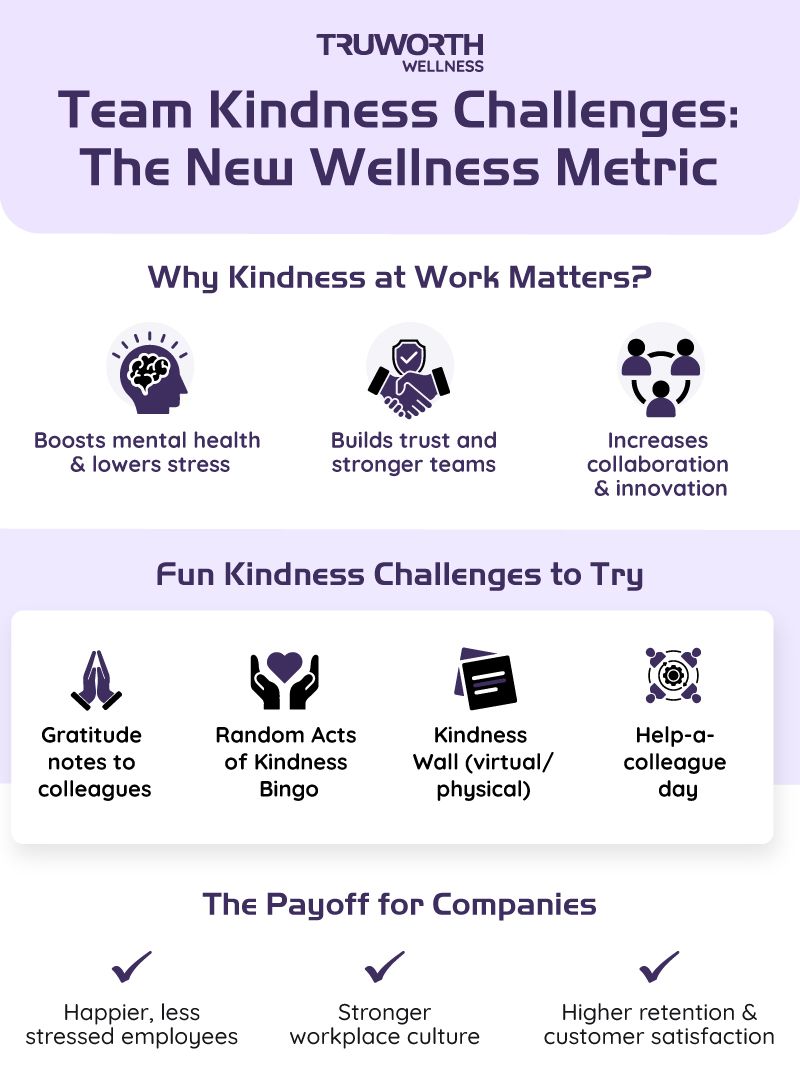Team Kindness Challenges: A Surprising Metric For Employee Wellness

When organizations talk about employee wellness, the conversation often revolves around physical health—steps walked, calories burned, BMI scores—or sometimes mental health indicators like stress levels and engagement scores. But wellness is far more than that. A workplace can offer the best yoga classes, nutrition webinars, and even gym reimbursements, yet if employees feel undervalued or isolated, wellness efforts fall flat.
One surprising, but powerful, wellness metric gaining attention is kindness—how employees treat each other in the workplace. And one way to build this into corporate wellness culture is through Team Kindness Challenges. These aren’t just feel-good exercises; they have measurable impacts on employee well-being, workplace morale, and even productivity.

Why Kindness Matters in the Workplace?
We often underestimate the role of small gestures—a thank you note, a helping hand on a project, or simply acknowledging someone’s contribution. Yet research shows kindness has profound effects:
- Boosts mental health: Performing or receiving kind acts triggers the release of serotonin and oxytocin, hormones that lower stress and promote feelings of happiness.
- Strengthens workplace bonds: When employees experience kindness, they feel safer, more connected, and more willing to collaborate.
- Improves resilience: Kindness builds emotional fitness. Teams that practice kindness recover faster from setbacks and navigate conflicts more smoothly.
In a corporate setting where burnout and competition are common, kindness offers a refreshing counterbalance—something most wellness KPIs fail to capture.
Introducing Team Kindness Challenges
Team Kindness Challenges are structured initiatives that encourage employees to engage in intentional acts of kindness within their teams or across departments. Think of them as mini well-being campaigns designed not around fitness trackers, but around human connection.
Instead of measuring how many steps were taken or calories burned, organizations measure:
- Number of kind acts performed
- Employee participation levels
- Peer recognition and gratitude expressed
These challenges create a culture where people notice, appreciate, and celebrate small but meaningful acts of care.
Also Check: Workplace Fitness Challenges For Effective Wellness Strategy
How Team Kindness Challenges Work?
A Team Kindness Challenge can be designed in simple, engaging ways. Some examples include:
- Daily Gratitude Notes: Employees write one note of appreciation each day to a colleague.
- Help-a-Colleague Day: Once a week, employees commit to helping someone outside their immediate team.
- Kindness Wall (Physical or Virtual): A shared space where employees post shoutouts for colleagues who went the extra mile.
- Random Acts of Kindness Bingo: A gamified board where employees tick off challenges like “Compliment someone’s work” or “Offer to mentor a junior colleague.”
- Kindness Chain: One kind act inspires the recipient to ‘pass it on,’ creating a ripple effect across teams.
Unlike traditional wellness challenges that often feel competitive, kindness challenges thrive on collaboration and inclusivity. Everyone wins, and the benefits are collective.

The Business Case for Kindness Challenges
From an HR and leadership perspective, investing in kindness is not just about being “nice.” It has measurable returns:
- Higher Employee Retention: A workplace culture built on appreciation makes employees less likely to leave.
- Enhanced Collaboration: Teams that practice kindness are more innovative because members feel psychologically safe.
- Reduced Stress Levels: Oxytocin released during kind interactions reduces cortisol, which directly impacts employee burnout rates.
- Improved Customer Service: Employees who experience kindness internally are more likely to extend it to clients and customers.
This makes kindness not just a “soft” metric, but a strategic one.
Measuring the Impact of Kindness
The challenge with kindness initiatives is quantifying results. But organizations can use creative ways to track impact:
- Kindness Logs: Employees report their acts of kindness in a shared platform.
- Pulse Surveys: Short surveys ask employees if they feel more supported, appreciated, or connected after challenges.
- Engagement Metrics: Compare engagement and collaboration data before and after challenges.
- Wellness Scores: Track correlations between kindness participation and stress reduction, absenteeism, or retention.
By capturing both qualitative feedback (stories of positive experiences) and quantitative data (participation rates), HR can position kindness as a meaningful wellness KPI.
Designing Kindness Challenges for Indian Workplaces
It’s important to design wellness initiatives that resonate culturally. In India, where collectivism and community values are strong, kindness challenges can be uniquely impactful if adapted thoughtfully.
- Celebrate Festivals with Kindness: Encourage employees to donate to a colleague’s chosen cause during Diwali or Eid.
- Language of Respect: In multilingual workplaces, a kindness challenge could involve learning greetings in each other’s languages.
- Mentorship Kindness: Senior employees can take up challenges to support juniors with career advice, reflecting the Indian tradition of guru-shishya bonds.
By rooting kindness initiatives in local values, organizations ensure authenticity and participation.
The Future of Wellness Metrics
As wellness strategies evolve, organizations are realizing that human-centered metrics like resilience, empathy, and kindness may matter more than traditional physical health scores. Team Kindness Challenges provide a fresh way to track well-being—not through BMI or gym attendance, but through the quality of human connections at work.
When companies celebrate kindness, they shift wellness from being an individual pursuit to a collective journey. And in the long run, this is what truly makes workplaces thrive.
Conclusion
Wellness at work is no longer just about physical fitness or stress management. It’s about building a culture where employees feel cared for, respected, and supported. Team Kindness Challenges offer an innovative way to measure and nurture that culture.
Incorporating kindness into wellness programs doesn’t just create happier employees—it creates stronger teams and healthier organizations. After all, in a workplace where kindness is the norm, well-being naturally follows.
At Truworth Wellness, we believe the future of workplace wellness lies in redefining success metrics—moving beyond weight scales and attendance sheets to include human connection, empathy, and kindness. Our tailored wellness programs help organizations design initiatives like Team Kindness Challenges that truly resonate with employees.
👉 To know how we can help your workplace build a culture of care and well-being, visit www.truworthwellness.com.
